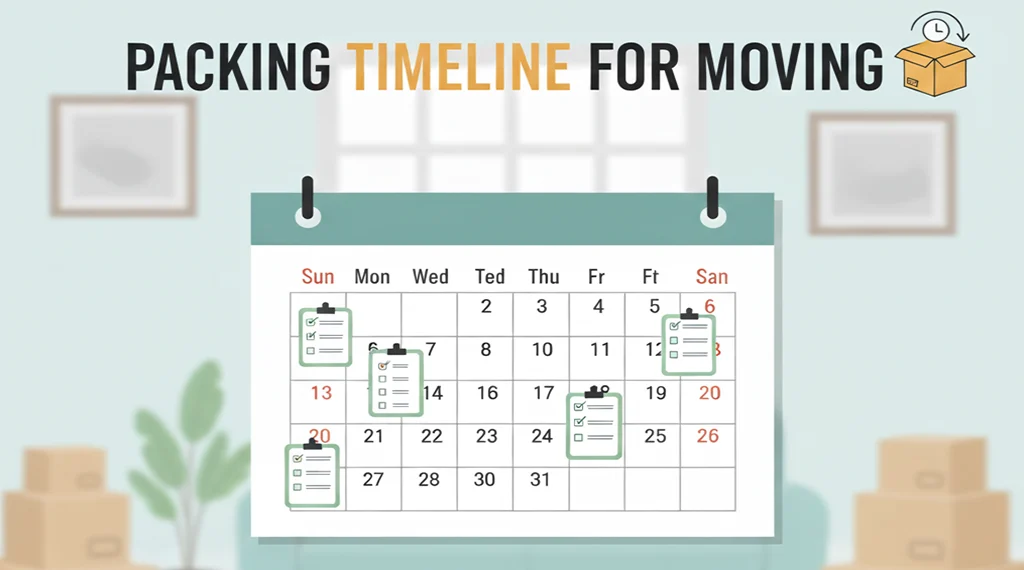The Ultimate Packing Timeline for Moving: What to Pack and When

Moving is more than just boxing up your belongings — it’s a carefully timed process that demands structure, planning, and patience. Whether you’re relocating across town or cross-country, the success of your move often comes down to one thing: organization.
A clear packing timeline helps you stay on track, avoid last-minute chaos, and ensure that nothing important gets left behind. Without one, it’s easy to fall into the trap of procrastination — leading to broken valuables, rushed packing, and sleepless nights before moving day.
This detailed guide from Van Lines Move walks you through a week-by-week packing plan, starting two months before your move and leading all the way to moving day. You’ll know exactly what to pack, when to pack it, and how to prepare for a stress-free relocation.
Why a Packing Timeline Matters?
A packing timeline isn’t just about staying organized — it’s your roadmap to a smooth, successful move. Here’s why it’s so important:
- Reduces stress: Breaking tasks into manageable chunks keeps you calm and in control.
- Saves time: You won’t waste hours searching for supplies or rushing at the last minute.
- Prevents damage: Packing in stages means you can wrap delicate items carefully.
- Improves efficiency: Labeling, inventory tracking, and planned packing reduce confusion during unpacking.
When you plan your move with intention, each stage flows naturally into the next — making the entire process more efficient and far less overwhelming.
8 Weeks Before Moving Day – Plan & Prepare
The earlier you start, the better your move will go. Two months before moving day is the perfect time to lay the groundwork for an organized, stress-free transition.
1. Create Your Moving Binder
A moving binder (or digital folder) keeps everything in one place — from quotes and receipts to inventory lists and contracts. Include:
- Moving company contact info
- Estimates and contracts
- Room-by-room packing lists
- Important dates and moving checklists
2. Start Decluttering
Go room by room and sort items into three categories: keep, donate, or toss. There’s no sense in moving things you don’t need. This is your chance to lighten your load and save on moving costs.
3. Research Moving Companies
Compare quotes, read reviews, and book a reputable moving company early, especially if you’re moving during peak season.
4. Gather Supplies
Stock up on sturdy boxes, bubble wrap, packing tape, labels, and permanent markers. Consider eco-friendly options like recycled boxes or reusable bins.
5. Take Measurements
Measure furniture and doorways in your new home to ensure everything fits. If something won’t work, now’s the time to sell or donate it.
6 Weeks Before Moving Day – Start Non-Essential Packing
Now that you’ve done the groundwork, it’s time to start packing non-essentials — the things you won’t need over the next month.
1. Pack Seasonal and Rarely Used Items
These might include:
- Holiday decorations
- Off-season clothing
- Books, DVDs, or collectibles
- Extra linens or kitchen gadgets
Pack these items neatly, label each box clearly, and note its contents in your binder.
2. Notify Property Managers or Landlords
If you’re renting, provide notice according to your lease agreement (usually 30–60 days).
3. Schedule Services
Plan ahead for utility shut-offs and new service setups. This includes:
- Electricity, gas, and water
- Internet and cable
- Trash pickup and mail forwarding
4. Request Time Off
If your move happens during the week, schedule vacation days or flexible work arrangements in advance.
4 Weeks Before Moving Day – Organize and Continue Packing
You’re halfway there! Four weeks out, start focusing on rooms and items you use less frequently.
1. Pack Storage Areas
Tackle basements, garages, and attics — the hardest spots to organize.
Sort through tools, seasonal décor, and outdoor gear. Dispose of hazardous materials properly.
2. Use Up Consumables
Start eating what’s in your pantry and freezer to minimize waste. Use up cleaning products, toiletries, and perishable foods.
3. Confirm Moving Details
Reconfirm your booking with the moving company and verify your insurance coverage.
4. Update Your Address
Notify USPS, banks, credit cards, and subscriptions. Don’t forget to update your address for:
- Driver’s license
- Online deliveries (Amazon, etc.)
- Employer and tax records
5. Prepare a “Do Not Pack” List
These include essentials you’ll need right up until moving day — like toiletries, pet items, or daily kitchenware.
2 Weeks Before Moving Day – Pack the Majority
Things are getting real! Two weeks before your move, you should be about 70–80% packed.
1. Pack Up the Kitchen
Start with dishes and cookware you rarely use. Leave only basic utensils and one or two pans for daily meals. Wrap fragile items carefully in packing paper or towels.
2. Disassemble Furniture
Take apart non-essential furniture, like guest beds or bookshelves. Keep screws and bolts in labeled plastic bags taped to the furniture piece.
3. Protect Important Documents
Gather passports, birth certificates, insurance papers, and moving contracts into a single folder or document box you’ll keep with you.
4. Arrange Pet and Childcare
Moving day can be hectic — schedule a sitter or daycare for a stress-free experience.
5. Clean as You Go
Don’t leave cleaning for the last day. Tackle one room at a time as it’s emptied.
1 Week Before Moving Day – Finalize and Label
The countdown begins!
1. Finish Packing Everything But the Essentials
At this point, your essentials should fit into a suitcase or overnight bag. Everything else should be sealed, labeled, and stacked neatly.
2. Pack a “First Night Box”
Include everything you’ll need for your first 24 hours in your new home:
- Toiletries and towels
- Bedding and pillows
- Snacks and water
- Chargers and electronics
- Basic kitchen items
- Cleaning wipes and toilet paper
3. Confirm All Arrangements
Double-check dates, times, and contacts with your movers. If you’re driving yourself, confirm your rental truck and fuel plan.
4. Back Up Files
Back up your computer, photos, and important data to a cloud drive or external hard drive — just in case.
5. Defrost Appliances
Defrost your refrigerator and freezer at least 48 hours before moving day. Wipe them dry to prevent mildew.
Moving Day – The Big Day
It’s finally here! If you’ve followed your packing timeline, you’ll be prepared and stress-free.
1. Pack Last-Minute Essentials
Grab your toiletries, medications, phone chargers, snacks, and clothes for the day.
2. Do a Final Walkthrough
Before leaving, double-check every closet, drawer, and cabinet. Ensure windows are closed and lights are off.
3. Take Photos
Photograph your old place (for rental deposit) and your furniture before loading.
4. Supervise the Move
Stay available to direct movers or assist friends. Keep important paperwork with you.
5. Lock Up
Leave keys, remotes, or entry passes as agreed with your landlord or buyer.
After the Move – Unpack Smart
Congratulations! You’ve made it. Now it’s time to settle in and make your new space feel like home.
1. Unpack Essentials First
Focus on your bedroom, bathroom, and kitchen — these help you function comfortably right away.
2. Dispose of Packing Materials
Flatten boxes, recycle wrapping paper, and keep a few boxes for future storage.
3. Inspect for Damage
Check boxes and furniture for any signs of damage. File claims promptly if necessary.
4. Set Up Utilities and Wi-Fi
If not already done, contact utility providers to confirm all services are active.
5. Personalize Your Space
Hang curtains, photos, and décor. Take your time arranging furniture to match your lifestyle.
Bonus Tips for Efficient Packing
Want to make your move even easier? Keep these expert tips in mind:
- Color-Code Boxes: Assign a color to each room using stickers or markers.
- Use Suitcases for Heavy Items: Books and electronics are easier to move this way.
- Photograph Electronics: Take photos of cable setups before unplugging.
- Label on Multiple Sides: Makes identifying boxes easier when stacked.
- Keep an “Open First” Label: Use this for your essentials or high-priority items.
- Use Clothes as Padding: Wrap fragile items with t-shirts or towels.
- Pack Smart: Fill every inch of box space but don’t overload — balance weight evenly.
Conclusion
Moving doesn’t have to be stressful. With a well-structured packing timeline, you’ll have a clear plan, stay organized, and reduce the chaos that often comes with relocation.
By starting early, packing strategically, and following these week-by-week steps, you’ll be able to enjoy a smooth, efficient, and worry-free move — whether you’re heading across the city or across the country.
If you’re looking for professional help to make your move even easier, Van Lines Move is here to guide you every step of the way — from planning and packing to transportation and setup in your new home.
FAQs: Packing Timeline for Moving
1. When should I start packing before moving?
You should start packing about 8 weeks before your move. Begin with planning, decluttering, and gathering supplies. Around 6 weeks out, pack items you rarely use, and by 2 weeks before moving day, you should be about 80% packed — leaving only daily essentials for the final week.
2. What should I pack first when moving?
Start by packing non-essential items such as seasonal clothing, books, decorations, and items stored in attics or basements. These are things you won’t need in the weeks leading up to your move. Save essentials like toiletries, kitchen basics, and bedding for the last few days.
3. How long does it take to pack a whole house?
The time required depends on your home size and how organized you are. On average:
- Studio or 1-bedroom apartment: 2–3 days
- 2–3 bedroom home: 5–7 days
- 4+ bedroom home: 1–2 weeks
- Creating a structured packing timeline ensures you spread the work evenly and avoid last-minute stress.
4. What should I keep out for moving day?
Keep a “moving day essentials box” with everything you’ll need immediately — important documents, chargers, toiletries, snacks, first aid kit, tools, a change of clothes, and basic kitchen items. This box should travel with you, not on the moving truck.
Categories
- Long Distance Moving153
- Local Moving118
- Commercial Moving40
- Residential Moving34
- Last – Minute Moving25
- Moving Tips & Lifestyle10
- Furniture Moving9
- Moving Tips & How-To Guides8
- Moving services6
- Moving Cost Calculator5
- state to state movers4
- Piano Moving3
- Car Transportation3
- Truck Rental3
- Moving Cost3
- moving tips3
- Local Move3
- Moving companies3
- best moving rates3
- cheap moving companies3
- affordable moving companies3
- full-service movers3
- Moving Cost Guides3
- Junk Removal2
- Moving Container2
- Senior Moving2
- Senior Relocation Moving Companies2
- Moving Tools2
- Moving Estimates2
- interstate moving2
- cross-country move2
- Household moving2
- Moving Tips & State Guides2
- Heavy Equipment1
- Senior Moving Services1
- office moving1
- office relocation1
- employee relocation1
- Car Transport1
- Vehicle Shipping1
- Car Shipping Services1
- Artificial Intelligence1
- Office Moving Services1
- Commercial Moving Companies1
- Corporate Moving Services1
- Corporate Movers1
- full-service moving companies1
- sustainable moving companies1
- green movers1
- Moving in US1
- Best places to move in 20251
- 2025 moving1
- Full-Service Moving Companies1
- Moving1
- Tips for moving1
- donate1
- sell1
- Movers in California1
- Movers in Studio City1
- Moving to California1
- Laws about Moving into California1
- Moving Laws1
- House moving1
- packing1
- cheap moving ways1
- Moving guide1
- International moving1
- moving across countries1
- international relocation program1
- move out cleaning1
- right packing supplies1
- pack while moving1
- Apartment moving1
- PODS1
- moving out1
- state to state move1
- California movers1
- Truck Rental1
- US Territory Relocation1
- International Moving1
- Shipping & Moving Tips1
- Moving Tips1
- Relocation Guide1
- Moving Budget Guide1
- Relocation Guides & Incentives1
- Moving Tools & Equipment Guides1
- Moving Costs & Budgeting1
- Moving Services & Options1
- Moving Tips & How-To Guides1
- Moving Day & Settling In1
- Mobile Home Moving1
- Moving Guide & Tips1
- Moving Tips & State Comparisons1
- Moving Tips & City Guides1
- Moving Tips & Cost Guides1
- Long-Distance Moving Tips1
- Moving Tips & Financial Planning1
- Moving Tips & Relocation Advice1
- Moving Tips & Home Preparation1
- Moving Tips & Planning1

 Local Movers
Local Movers Last-Minute Movers
Last-Minute Movers Junk Removal
Junk Removal Long Distance Movers
Long Distance Movers Piano Movers
Piano Movers Heavy Equipment
Heavy Equipment Commercial Movers
Commercial Movers Moving Container
Moving Container Car Transportation
Car Transportation Furniture Movers
Furniture Movers Truck Rental
Truck Rental Moving Cost Calculator
Moving Cost Calculator Moving Planner
Moving Planner Packing Calculator
Packing Calculator Moving Checklist
Moving Checklist Moving Insurance
Moving Insurance FAQ
FAQ Contact Us
Contact Us Moving Loan
Moving Loan About Us
About Us











